Main Menu

M.1892 Zeltbahn (Tent Half) and Accessories
Tent shelters were introduced in Germany in 1892. The reason for its introduction was explained by the War Ministry as follows: "By reason of the increase of the masses which will compose the field armies in the future, the cantonment will be the exception while the bivouac will become the rule for troops in the theater of operations. The necessity then imposes itself of guaranteeing the health and vigor of the men sheltering them against cold and rain."
All NCOs and enlisted men were equipped with a Zeltbahn and its accessories Zeltgräte; while the mounted troops (cavalry, field artillery and train) were not so equipped. The portable Zeltbahn Equipment Zeltgräte '92 consisted of the shelter half Zeltbahn with shelter half guyline Zeltleine, the 3-piece tent pole Zeltpflöcke and three tent pins Zeltstöcke.
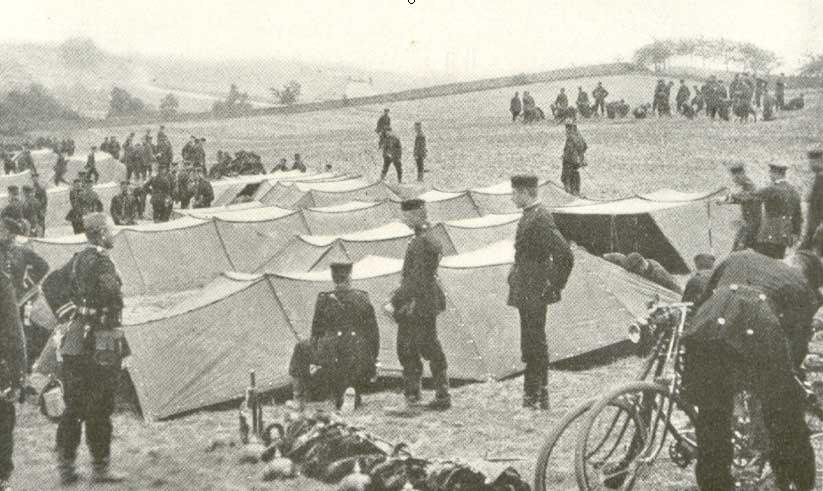
Pre-war photo of Zeltbahnen being set-up in the field.
Zeltbahn (Shelter Half)
The square shelter half was made of brown waterproof cotton canvas material and measured 165 cm x 165 cm. Since the material was mass produced in a width of 94-95 cm, the finished Zeltbahn consisted of two pieces joined at the center by a felled double seam and the edges were doubled over to a width of 7 cm for durability. In order to connect two shelter halves, 8 aluminum buttons and buttonholes were placed on each side. In each corner was a large aluminum eyelet (inside diameter 1.5 cm and outside diameter 3.3 cm) and 3 small aluminum eyelets (inside diameter 0.6 cm and outside diameter 1.8 cm), in the middle of each side were placed two smal eyelets. The small eyelets served for reception of six tent rope pieces (Zeltleinen) of 28 cm in length with knotted ends which created 6 loops through which one pulled the tent rope pieces. On the inside of the shelter half, in the middle, were sewn 5 loops, and near the hem were sewn 6 loops in incremental distances from the center seam of 2, 3 and 6 cm. These loops served for the reception of the shelter half line and neck cord. The 2 meter long shelter half guy-line was to be made of black colored hemp and came out on both ends in a knot. The 90 cm long neck cord was also made from blackened hemp and was firmly sewn at the center seam, 18 cm from the edge, and was pulled through the loops provided for it; its ends were wrapped with black twine to a 2 cm length. For protection from the rain, the shelter half could be draped over the shoulders and tied around the neck with the neck cord; in this manner the shelter half guy-line was also pulled through the 5 loops in the middle and was tied around the hips.
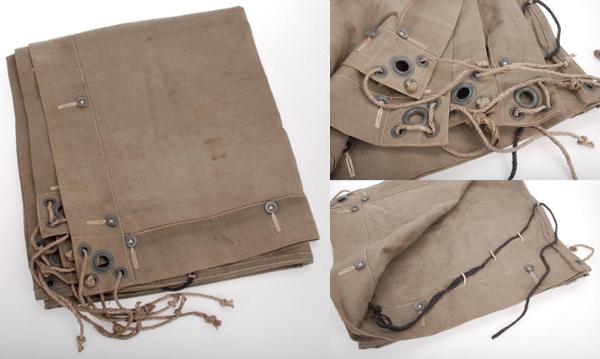
Original Zeltbahn.
Soon after the beginning of the war, wearing the shelter half buckled onto the outside of the Tornister proved too conspicuous due to its red brown color, which made the wearer a good target for enemy snipers. Therefore, a Prussian decree of August 27, 1914 permitted soldiers to buckle the greatcoat over the shelter half, when necessary, in order to conceal it. To simply do away with the disadvantageous brown color altogether, the Prussian War Department issued a decree on October 15, 1914 for the shelter half to be made of grey waterproof canvas material.
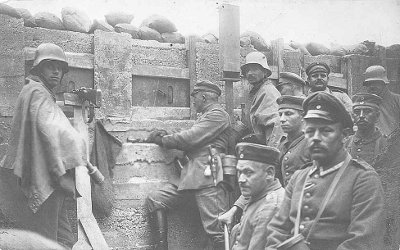
Original photo of a group of soldiers, more than one using their Zeltbahn as a rain-cape.
In addition, the buttons and eyelets were also specified to be prepared from brass instead of aluminum. This change was accepted by Bavaria on November 6, 1914, Saxony on October 27, 1914, and Württemberg on October 31, 1914. Shortly after, on March 2, 1915, another decree was issued for a new shelter tent material of a lighter construction, reducing the weight from 1160g to 900g. For saving bright metal (Buntmetalle), a Prussian decree of January 1, 1915 and a Bavarian decree of January 16, 1915 permitted the use of buttons and eyelets made from galvanized iron or steel.
There were still a large stock of brown shelter halves that continued to be issued in spite of the new gray shelter halves; this was also forced due to the shortage of cotton in the manufacture of materials. Thus, the Prussian Army Administration had to issue orders on May 29, 1916 to deny the exchange of brown shelter halves for gray on economic grounds. There was a decree on August 8, 1916, that extended the earlier ruling of buckling the ochre shelter half under the greatcoat to allow this practice as a general practice not only for front line troops, but for all troops. In order to comply with the wishes of the troops to have gray shelter halves, the Saxon War Department allowed the present brown shelter halves to be redyed. On the other hand, the Prussian War Department regarded the dyeing experiments of ochre material as unsatisfactory and rejected a redyeing of the in stock shelter halves on April 20, 1917.
As a result of the cotton shortage, it was permitted by Prussian decree of December 20, 1917 that the materials for shelter halves were to be made from mixed threads (70% cotton and 30% rayon waste). To save as much material as possible, on July 25, 1918, the Prussian War Department prescribed for a reduction in the width of the shelter half material from 94-95 cm to 91 cm but without changing the proportions of the shelter half; the Bavarian War Department accepted this on August 10, 1918. Finally, according to Prussian decree of October 2, 1918, and respectively a Bavarian decree of October 10, 1918, shelter halves were to be sewn together with multiple pieces of material.
Also as a result of the shortages, the Leinenstrippen, shelter half guy-line and neck cords were made from tarred woven paper of 4 mm strength and the ends secured with tin-plated sheet-metal clips; these changes were ordered the Bavarian War Department on May 26, 1917 and the Saxon War Department on May 24, 1917. On July 12, 1917, the Prussian War Department also issued similar orders for a similar pattern change for the shelter half guy-line, which was from then on to be made of woven paper. Bavaria followed on September 1, 1917.

Photo of a 2-man shelter created with reproduction Zeltbahnen
Zeltpflöcke (Tent Poles), Zeltstöcke (Tent Pegs) u. Zeltzubehörbeutel (Tent Accessories Bag)
Zeltpflöcke (Tent Poles)
The Tent Pole '01 is composed of three 37 cm long cylindrical poles made of ash, where the end of one would fit into the end of the other. The tent pegs '01 consisted of 26.5 cm (10.2") long ash rods with a rectangular cross section and metal fittings on the ends with a small iron rod - for holding the tent line - projected at a downward slant from the top.
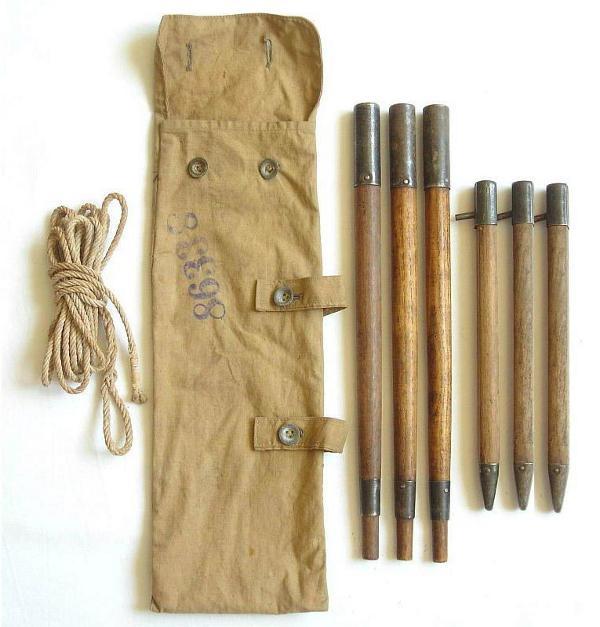
Original set of Zeltbahn accessories.
Zeltstöcke (Tent pegs)
The tent pegs '01 consisted of 26.5 cm (10.2") long ash poles with a rectangular cross section of 1.9 cm x 1.4 cm (0.74" x 0.55"). They had on the lower end a 4.1 cm (1.6") long, wedge-shaped metal fitting and on the upper end a similar long rectangular metal fitting made of blackened iron, from which a 1.6 cm (.63") long iron rod - for holding the tent line - projected at a downward slant. A set of three tent pins weighed 210g.

Set of 3 original wood Zeltstöcke '01
Since the wooden tent pegs often broke with driving them into hard ground, the Prussian Army Administration ordered testing with tent pins made of steel. As a result, the Prussian War Department introduced on March 2, 1915 the steel 'Zeltpflock 15' - they had a length of 10" (25.5cm) and were made of cold-drawn, galvanized steel half-pipe with a 2.3 cm long head piece with eyelet. For more ease of pulling the pins out of the ground, they were furnished with a hemp loop. Tent pins made of wood, when possible, were no longer to be provided and the new pins were first issued to the troops on the Eastern Front. The new steel tent pins were introduced in Bavaria on March 20, 1915, to Saxony on March 16, 1915 and to Württemberg on March 11, 1915.
These "half-pipe" steel pegs proved unsatisfactory in wide use and a Prussian direction of April 16, 1915 revised the pin design. The new steel pegs had a length of 26 cm with a width of 1.5 cm and a D-shaped cross-section with a welded steel wire eyelet. Through this eyelet was an 11 cm long rope loop with knotted ends. The weight of the three tent pins with rope loops came to 380g. These pegs were accepted by Bavaria on April 27, 1915, in Saxony on April 30, 1915 and in Württemberg on April 26, 1915.
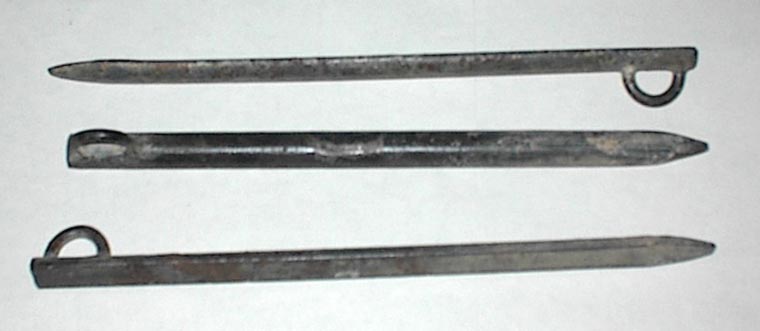
Original set of second run steel tent pegs.
Because the production of these tent pins proved to be rather expensive, the Prussian War Department issued a new order for a more economical tent pin. The new pins were to be made of galvanized steel and also 26 cm long, but with two hollow grooves and a 2.7 cm long head with eyelet through which a 37-40 cm long rope loop with knotted ends was to be pulled. The weight of three tent pins remained unchanged at 380g. These tent pins were introduced by Bavaria on October 25, 1915, accepted by Saxony on November 16, 1915 and by Württemberg on October 22, 1915.

Original set of the final pattern economy steel tent pegs.
However, there remained a great deal of wooden tent pins in stock that first had to be used up (nearly 1.6 million). Therefore, on September 15, 1916 the Prussian War Department ordered the supply of the expensive steel pins to halt. The Bavarian War Department followed this measure on September 26, 1916.
Zeltzubehörbeutel (Tent Accessories Bag)
The three tent poles (Zeltstock), thethree tent pegs (Zeltpflöcke) and tent ropes (Zeltleine) were carried in a 38 cm (14.8") long ocher (or later gray) canvas bag (Zeltzubehörbeutel) and placed under the cover flap of the backpack. The bag was attached to the Tornister with two leather straps and closed at one side with two zinc buttons. The two leather straps were either closed with two buckles (standard issue) or with two buttons (variation). Examples have been observed as well where the two leather straps were replaced with two cloth straps closed with buckles.
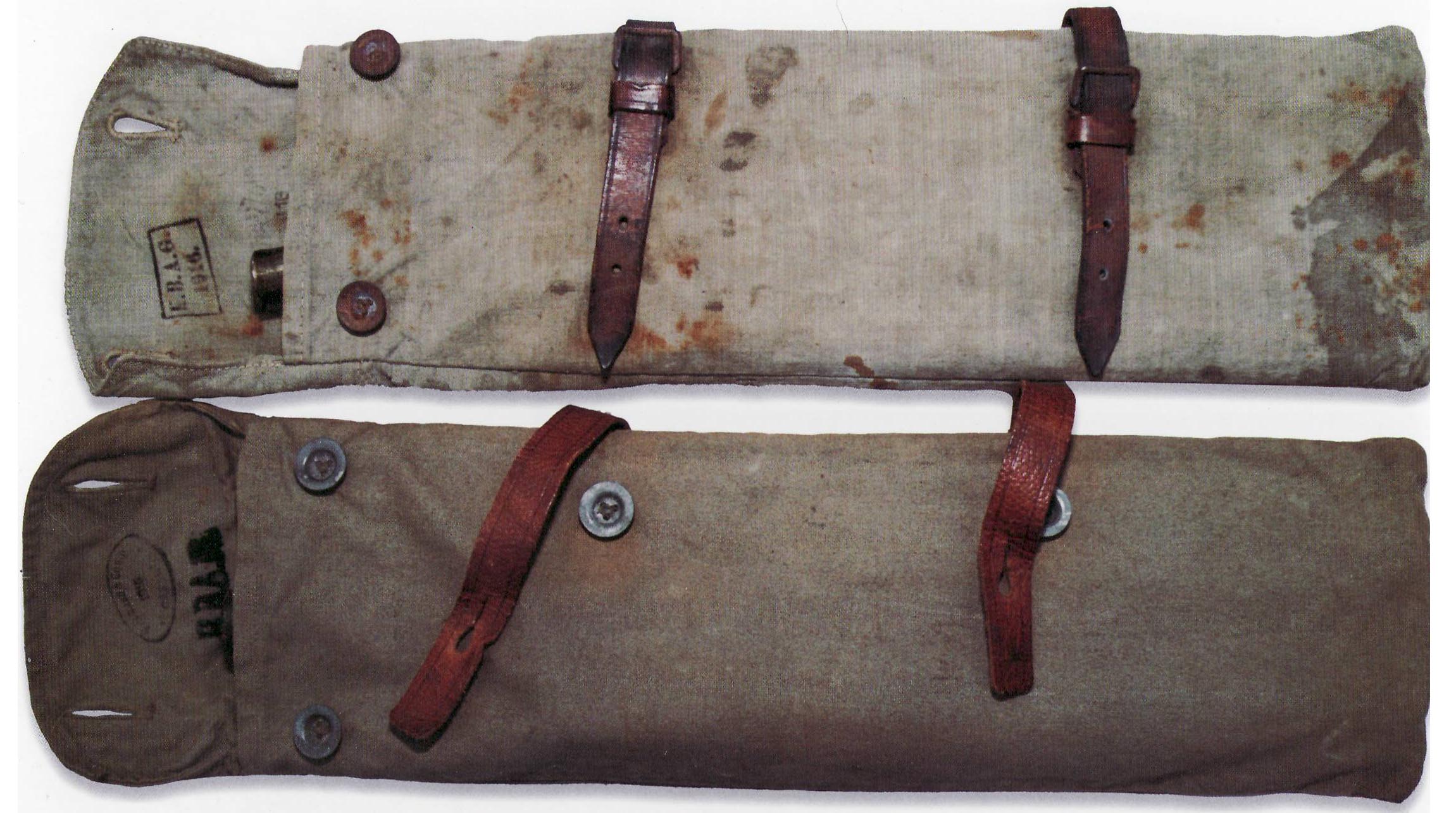
The bag at the top is an original grey canvas bag with leather straps with
roller buckles while the lower bag is a variation that buttons.

This original bag is the Ersatz variation with the attachment straps made from canvas.
References
- Feld-Pionierdienst aller Waffen. Mittler & Sohn, Berlin, 1911.
- Somers, Johan, Imperial German Field Uniforms and Equipment 1907-1918. Schiffer Military History, Atglen, PA, 2005.
- Fisch, Robert, Field Equipment of the Infantry. Greenberg Publishing Company, Inc., Sykesville, MD, 1989.
- Le Fantassin De la Grande Guerre 1914/1918.